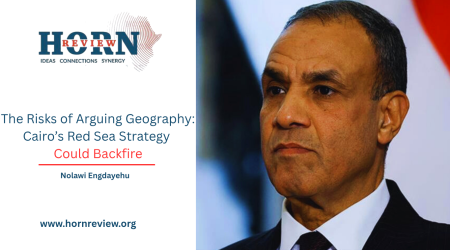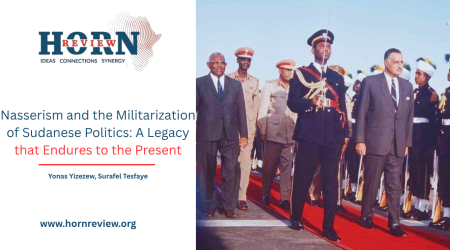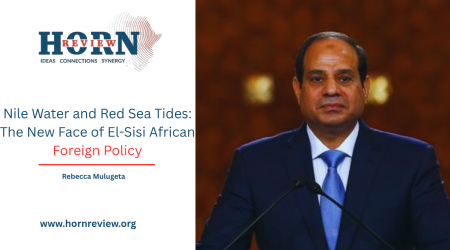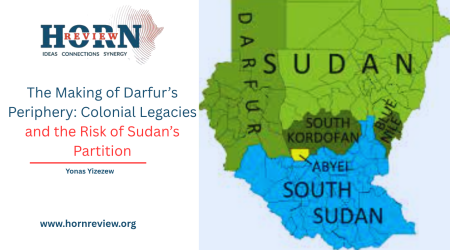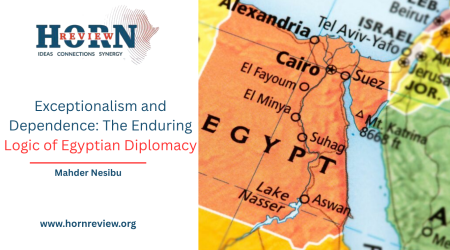
15
Nov
Beyond the “Small State Syndrome”: Why the World Must Confront the Realities of the Ethiopia–Eritrea Crisis
By Blen Mamo
For far too long, the international community – most notably Western governments, policy institutions, and media outlets – has interpreted the Ethiopia–Eritrea relationship through a framework that is both analytically deficient and strategically counterproductive. What can be termed a persistent “small state syndrome” continues to dominate external perceptions: a tendency to view Eritrea as a vulnerable miniature polity whose actions must be excused or contextualized, while simultaneously casting Ethiopia as a presumptive aggressor on the basis of size alone.
This conceptual bias has obscured the structural drivers of instability, distorted diplomatic engagement, and allowed narratives untethered from historical or empirical reality to shape international policy. As a result, external actors have failed to confront the ideological and institutional roots of the crisis – roots that were articulated with clarity and historical rigor in Ethiopia’s Foreign Minister’s comprehensive address at the recent Foreign Policy Forum organized by Horn Review and Addis Ababa University.
As underscored in that forum, the Ethiopia–Eritrea impasse is neither a mere port dispute nor a conventional border disagreement. Rather, it reflects a long-standing pattern in which the Eritrean state – guided by a worldview consolidated over multiple decades – has embedded insecurity, militarization, and regional destabilization as pillars of its political identity. This dynamic has remained remarkably consistent irrespective of Ethiopia’s posture. Concessions, rapprochement initiatives, and periods of restraint have had little effect on altering Eritrea’s behavioral trajectory. Yet this fundamental asymmetry remains insufficiently understood by external observers.
Concurrently, Ethiopia’s conduct has reflected a level of restraint that stands in stark contrast to the behavior of many states – Western and others alike – when confronted with comparable provocations. Ethiopia today faces the occupation of its sovereign territory by Eritrean forces. It confronts systematic efforts by Eritrean security organs to cultivate insurgencies, finance destabilizing networks, traffic arms, and carry out covert operations on Ethiopian soil – allegedly backed by Egypt. Any western or non-western state subjected to even a fraction of these violations would invoke Article 51 of the UN Charter without much hesitation. History provides ample evidence: European powers initiated global conflicts over provocations far smaller than those directed at Ethiopia today, and governments, including that of the United States, have repeatedly undertaken military interventions across continents on the basis of ideational or anticipatory threats that pale in comparison to direct incursions by an adjacent state.
This pattern of inconsistent standards extends beyond Western capitals. Egypt, for instance, has for decades justified coercive diplomacy, military signaling, and the sponsorship of hostile actors inside Ethiopia based on expansive claims to “historic rights” over the Nile – claims lacking any foundation in contemporary international law. Cairo has mobilized pressure campaigns, threatened force, and orchestrated encirclement strategies over issues far less immediate than the direct and ongoing violations Ethiopia endures from Eritrea. Yet many of the same governments that readily accommodate Egypt’s maximalist positions remain conspicuously muted when Ethiopia’s territorial integrity is breached in clear and unambiguous terms. The asymmetry is striking and reveals the degree to which Ethiopia has exercised a patience and restraint that others do not expect of themselves.
Despite these realities, the international community has too often failed to recognize the structural imbalance at the heart of the crisis. The reflexive assumption that small states are inherently defensive has resulted in a profound misreading of Eritrea’s intentions and strategic orientation. Eritrea’s posture is not reactive; it is the product of a deeply entrenched ideological doctrine – what Ethiopia’s Foreign Minister termed the “Isaias Doctrine” – which posits that Eritrea’s survival is best ensured by maintaining Ethiopia in a state of persistent vulnerability or fragmentation, while simultaneously interfering unlawfully in the internal affairs of states beyond its immediate neighborhood, fomenting disorder and undermining regional stability. Beyond this historical pattern and despite its modest size and limited resources, Eritrea’s worldview is also evident in its prioritization of militarization over development, and its deep entanglement in illicit transnational networks that benefit from regional instability.
Further compounding this misreading is the international community’s reluctance to acknowledge the distinctive nature of the Eritrean state. Eritrea does not operate like a conventional polity. It does not center its governance on economic development, citizen welfare, or institutional pluralism. Its political and economic structures are configured for permanent mobilization, pervasive securitization, and systemic suspicion of integration or normalization. In addition to its lack of political will for peace, as Ethiopia’s Foreign Minister noted, Eritrea lacks the institutional architecture necessary for ordinary diplomatic engagement – a reality that is not incidental but intrinsic to its governing model.
A careful reading of Eritrea’s recent public statements – particularly those disseminated through its Ministry of Information – reveals a deliberate effort to invert reality and portray Ethiopia as the source of tensions, despite overwhelming evidence to the contrary. This pattern is not incidental; it aligns with Eritrea’s long-standing strategy of projecting victimhood while obscuring its own established record of regional destabilization. Indeed, Eritrea’s communications increasingly rely on deflection and rhetorical dismissal rather than substantive engagement with the facts or the structural issues at hand, allowing propaganda to substitute for argument and selective grievance to stand in for evidence. Ethiopia has articulated no war agenda of any kind, and its references to maritime access have consistently been framed in terms of peaceful negotiation, economic logic, and regional integration – positions deliberately recast by Asmara as “irredentist” for political effect.
As Ethiopia repeatedly emphasized, its pursuit of diversified maritime access is not grounded in irredentist ambitions over Asab, a territory illegitimately severed from its former sovereign. Ethiopia rather significantly invested in reconciliation efforts, especially post 2018. It has repeatedly taken steps that reflect a preference for peaceful coexistence. Yet Eritrea’s hostility endured even when Ethiopia had no maritime aspirations whatsoever – and even at a talking about Assab was considered a crime pre-2018. This chronology makes clear that the underlying tensions far predate port access and cannot be reduced to it. So, far from addressing the region’s core challenges, such Eritrean reductionist and deflective tactics function only to divert attention from Eritrea’s continued interference, and its refusal to participate constructively in any framework of stability. As Asmara recycles outdated narratives for propagandistic ends, the broader regional imperative remains one of de-escalation, institutional dialogue, and adherence to empirical reality rather than incendiary rhetoric.
However, instead of grappling with these structural realities, many external actors have maintained analytical frameworks that attribute the crisis to Ethiopia’s size or miscast its intentions. These interpretative errors have enabled Eritrea’s spoiler behavior to flourish while placing unrealistic and inequitable expectations on Ethiopia – a state that has consistently pursued normalization, even at considerable political and strategic cost.
With that note, it is essential that Western policymakers refrain from approaching the Ethiopia–Eritrea question through the familiar prism of austere instruments or coercive leverage. Even as a conceptual orientation, a reliance on pressure-based frameworks risks misdiagnosing both the nature of the problem and the political anatomy of the actors involved. Such tools are often predicated on assumptions of institutional symmetry, rational deterrence, and reciprocal state behavior – assumptions that do not accurately map onto the Eritrean political system or the structural roots of the current tensions. Moreover, pressure oriented logics have a tendency to reinforce the very analytical distortions this article critiques: they inadvertently reproduce the “small-state syndrome,” treating Eritrea as inherently vulnerable or reactive and Ethiopia as automatically responsible by virtue of size, rather than attending to the documented patterns of destabilization that have emanated from Asmara. For these reasons, analytical frameworks that lean toward punitive thinking – even implicitly – are unlikely to contribute to de-escalation or meaningful resolution. What is required instead is a clear-eyed, historically grounded, and structurally informed assessment capable of addressing the actual sources of instability and encouraging constructive compromise before any escalation occurs.
Where the international community genuinely seek to prevent the escalation of tensions, the tools available to them are both clear and actionable. They can exert targeted diplomatic pressure on actors whose ambivalence or obstruction undermines de-escalation. They can reinforce the inviolability of territorial integrity as a foundational principle. They can support early-stage dialogue mechanisms, provide disincentives for escalation, and ensure that deliberate attempts to sabotage peace are met with commensurate consequences. Such interventions would meaningfully contribute to conflict prevention – unlike actions deployed reflexively or symbolically.
Ethiopia, for its part, has repeatedly demonstrated its preference for peace, not as an expression of weakness but as a reflection of strategic maturity. Nevertheless, Ethiopia cannot be expected to absorb perpetual provocation while being counseled on restraint by states whose own histories reflect far lower thresholds for military response. A nation of Ethiopia’s kind, with a historical commitment to regional stability, cannot reasonably be asked to accept continuous threats to its sovereignty without reciprocal expectations placed upon the provocateur.
Thus the question confronting the international community is both urgent and unavoidable: Will it continue to apply a simplistic moral framework in which small states are presumed innocent and large states presumed culpable, irrespective of empirical realities? Or will it finally acknowledge the historical, ideological, and structural factors that have long destabilized the Horn of Africa – factors articulated with clarity by Ethiopia and borne out through decades of lived experience?
Sustainable peace in the region requires the abandonment of comforting illusions and the adoption of historically grounded, analytically rigorous, and strategically coherent approaches. Only through such a recalibration can the Horn of Africa move toward the stability, cooperation, and shared prosperity that Ethiopia has consistently championed and continues to advocate with principled resolve.
About the Author
Blen Mamo is the Executive Director of Horn Review, an independent research and publication think-tank focused on politics, diplomacy and security in the Horn of Africa. She is also an Associate Researcher at the Ethiopian Institute of Foreign Affairs, Executive Editor of Horn Review publications, and Executive Producer of the Strategic Dialogue Podcast Series Co-Produced by the Horn Review & the Institute of Foreign Affairs. She holds an LLB, and MSc in International Security & Global Governance from the University of London.



